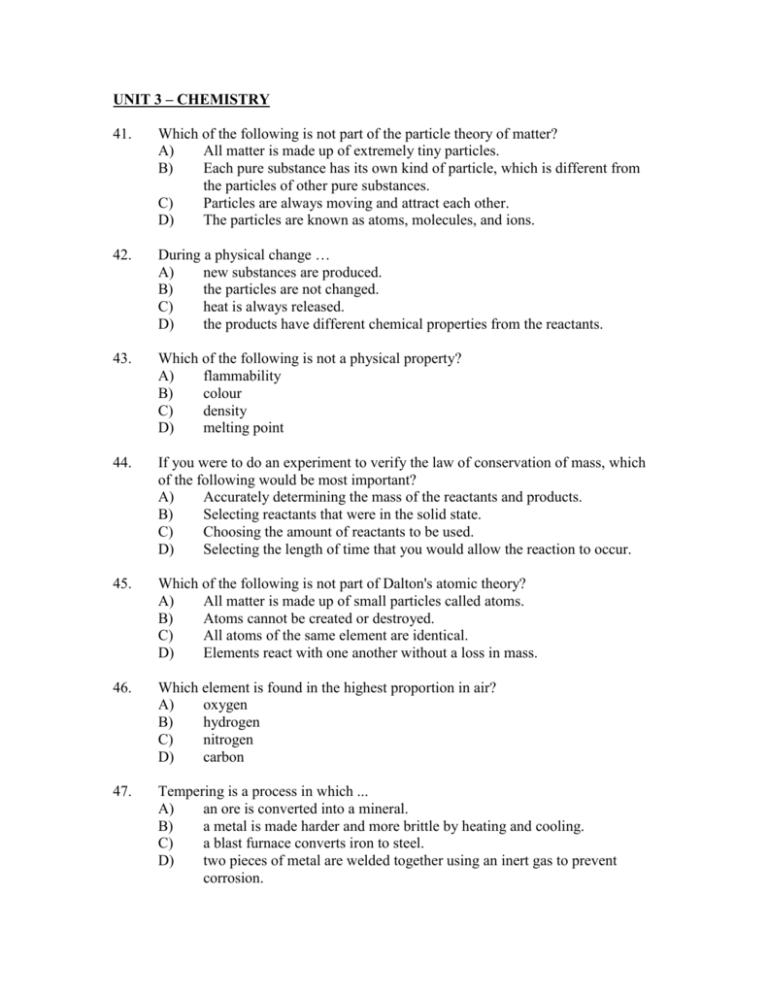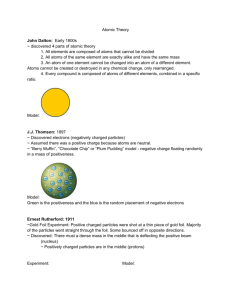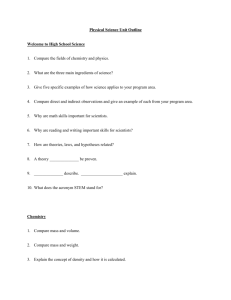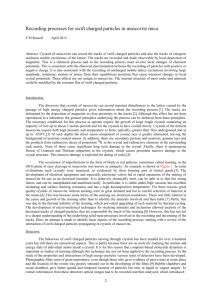chem
advertisement

UNIT 3 – CHEMISTRY 41. Which of the following is not part of the particle theory of matter? A) All matter is made up of extremely tiny particles. B) Each pure substance has its own kind of particle, which is different from the particles of other pure substances. C) Particles are always moving and attract each other. D) The particles are known as atoms, molecules, and ions. 42. During a physical change … A) new substances are produced. B) the particles are not changed. C) heat is always released. D) the products have different chemical properties from the reactants. 43. Which of the following is not a physical property? A) flammability B) colour C) density D) melting point 44. If you were to do an experiment to verify the law of conservation of mass, which of the following would be most important? A) Accurately determining the mass of the reactants and products. B) Selecting reactants that were in the solid state. C) Choosing the amount of reactants to be used. D) Selecting the length of time that you would allow the reaction to occur. 45. Which of the following is not part of Dalton's atomic theory? A) All matter is made up of small particles called atoms. B) Atoms cannot be created or destroyed. C) All atoms of the same element are identical. D) Elements react with one another without a loss in mass. 46. Which element is found in the highest proportion in air? A) oxygen B) hydrogen C) nitrogen D) carbon 47. Tempering is a process in which ... A) an ore is converted into a mineral. B) a metal is made harder and more brittle by heating and cooling. C) a blast furnace converts iron to steel. D) two pieces of metal are welded together using an inert gas to prevent corrosion. 48. A family of elements ... A) is located in a vertical group on the periodic table. B) is located in a horizontal row on the periodic table. C) is a group of elements related by size and colour. D) is another name for a period on the periodic table. 49. The family of elements known as the halogens ... A) are all gases at room temperature. C) B) are unreactive. D) are in Group 17. react with the inert gases. 50. In what state of matter are most of the elements known today? A) solid B) liquid. C) gas D) None of the above. 51. Which of the following will deflect a cathode ray? A) only a negatively charged plate B) only a positively charged plate C) both a negatively and a positively charged plate D) a plate with no charge 52. Which does the nucleus of an atom contain? A) most of the mass and all of the positive charge B) most of the mass and some of the positive charge C) little of the mass and all of the negative charge D) little of the mass and all of the positive charge 53. What happened during Rutherford's gold foil scattering experiment? A) Most of the alpha particles reflected back toward the source. B) Most of the particles went through the foil without deflection. C) Most of the particles deflected a bit. D) Most of the particles were absorbed by the gold foil. 54. In his gold foil scattering experiment, Rutherford suggested that most of the alpha particles went through the foil because ... A) they were moving very quickly. B) the nucleus is very dense. C) they are the same charge as the atom's nucleus. D) the atom is mainly empty space. 55. Atoms that are isotopes ... A) have the same atomic mass. B) have the same atomic number. C) have the same number of neutrons. D) have different atomic numbers. 56. Which is not a property of ionic compounds? A) usually soluble in water B) conductor as a solid and in aqueous solution C) have high melting and boiling points D) hard crystalline solids 57. How many valence electrons are found in atoms of sodium? A) 1 B) 2 C) 6 D) 8 58. An ion is ... A) the basic unit of molecular substances. B) an atom that has gained or lost protons. C) the attraction between metal and non-metal atoms. D) a charged particle. 59. Molecular compounds ... A) are hard, high melting solids. B) are held together by molecular bonds. C) are formed when non-metals react with other non-metals. D) are compounds like NaCl and MgO. 60. Which of the following pairs of elements would likely form an ionic compound? A) sodium and potassium B) potassium and barium C) barium and sulfur D) sulfur and chlorine









